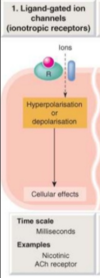S1) Biological Signalling Molecules Flashcards
What is pharmacology?
Pharmacology is the study of molecular signallers regulating physiological processes
What are the main extracellular signalling groups?
- Autocrine
- Paracrine
- Endocrine
Classify the 3 main extracellular signalling groups by the distance / volume over which they act
- Autocrine: target site is on the same cell (self stimulation)
- Paracrine: target site is on adjacent cell
- Endocrine: target site is on distant cell (travels through blood)

Describe 2 properties of endocrine signalling molecules
- Highly potent
- Global signal route (released into bloodstream)
Identify the 3 major types of endocrine signalling molecules
- Hydrophilic 1: amino acid derivatives
- Hydrophilic 2: peptides
- Lipophilic: steroids
Describe 3 properties of amino acid derivatives (hydrophilic 1 molecules)
- Small
- Hydrophilic (charged)
- Plasma membrane receptors (extracellular)
Describe 2 properties of peptides (hydrophilic 2 molecules)
- Chain length varies
- Plasma membrane receptors (extracellular)
Describe 2 properties of steroids (lipophilic molecules)
- Derived from cholesterol
- Nuclear receptors (intracellular)
Identify 3 examples of endocrine signalling molecules
- Adrenaline (A&E use)
- Insulin (diabetics)
- Steroids (anti-inflammatories)
State 3 actions of paracrine signalling molecules
- Signalling coupled from cell-to-cell
- Molecules are released into extracellular environment
- Induces changes in receptor cells (behaviour/differentiation)
Neurotransmitters are example of a paracrine signalling molecule.
Describe their mechanism of action
Neurotransmitters allow for the tight coupling of signalling molecule transmission over synapse (electrochemical) one way transmission
Distinguish between the actions of the excitatory and inhibitory neurotransmitters
- Excitatory: signal increase firing rate post synaptically
- Inhibitory: signal decrease firing rate post synaptically
Identify the 3 different neurotransmitters
- Acetylcholine
- Monoamines
- Amino acids
Provide 3 examples of amino acid neurotransmitters and their signalling function
- Glutamate: excitatory
- Glycine: inhibitory
- Gaba: inhibitory
Provide 3 examples of monoamine neurotransmitters and their signalling function
- Adrenaline: excitatory
- Noradrenaline: excitatory
- Dopamine: excitatory & inhibitory
- Serotonin: excitatory
What is the signalling function of acetylcholine?
Excitatory at an end organ
Provide 3 examples of paracrine signalling molecules in use
- Parkinsonism: uses dopamine precursors
- Epilepsy: uses GABA receptor modulators
- Hypertension: antagonises adrenaline/noradrenaline
What is the action of autocrine signalling molecules?
Cells respond to their own released signalling molecules
What happens when signalling molecules bind to their target?
- Signalling molecules bring about a change in functional status
- Original signal is transformed to produce another signal which performs a signal-dependent specific task (transport or synthesis)
- or direct interconversion between potential and kinetic energy
How can drug targets be classified?
R – receptor
I – ion channels
T – transporters
E – enzymes
How can receptors be classified?
- Kinase linked Receptors
- Ligand gated/Ionotropic Receptors
- Nuclear Receptors (intracellular)
- GPCRs (metabotropic)
all of them need a ligand
Describe the action of Kinase linked Receptors
- Mediate signals of wide variety of protein molecules
- E.g. growth factors cytokines hormones*
- Act via phosphorylation of specific groups
- E.g. Growth/differentiation*

Describe the action of Ionotropic receptors
- Bind with ligand gate ion current for duration of binding
- Allow ion currents and voltage change
- E.g. fast neurotransmitters* ACh & GABA

Describe the action of nuclear/intracellular receptors
- Ligands need to be lipid soluble e.g. steroids
- Bound ligand-receptor complex migrates to nucleus (if not already there) then binds to gene transcription factor
- Activates/inactivates a gene or set of genes

Describe the action of G-Protein Coupled Receptors
- Largest receptor group
- Slow neurotransmitters e.g. Musc ACh, serotonin, adenoreceptors
- Three major types: Gs, Gi, Gq

What are the functions of ion channels?
- Selectively allow ion current to flow across the plasma membrane
- Regulate voltage signals in excitable cells maintain membrane potential
What are the four major ion currents?

What is the function of transports/carriers?
Transport of ions / small molecules that can use channels (facilitated diffusion)
When is transport needed and what does it use?
- Transport needed if highly polar or going against gradient e.g. Na+/K+ ATPase
- Uses ATP as energy source or pre-existing ion gradient (symport/antiport)
What are enzyme functions?
Signal Processing Transformation:
- Synthesis
- Degradation
How can one target enzymes?
- Competitive inhibition at active site
- Increase levels of precursor substrate
signalling molecule classification
endogenous - (within body)
exogenous 1 - natural (plant based, morphine, asprin)
exogenous 2 - synthetic
picomolar
10-12
nanomolar
10-9
time course of action of endocrine signalling molecules
catacholamines - milliseconds - seconds
peptides and proteins - mins to hours
steroid - hours to days
receptor location of endocrine signalling molecules
catacholamines- plasma membrane
peptide - plasma membrane
steroid - cystolic or nuclear
mechanism of action for endocrine signalling molecules
catacholamines - change in membrane potential triggers cystsolic second messengers
peptides -triggers cystsolic second messengers
steroids - receptor - hormone conplex controls transcription factor
endogenous signallers are agonists
receptor is in a particular active state
exogenous signalling molecule
- acts as antagonists and blocks the biological signal
- carries an imposter signal
- side effects possible
- they cab be manufactured versions of the endogenous molecule


